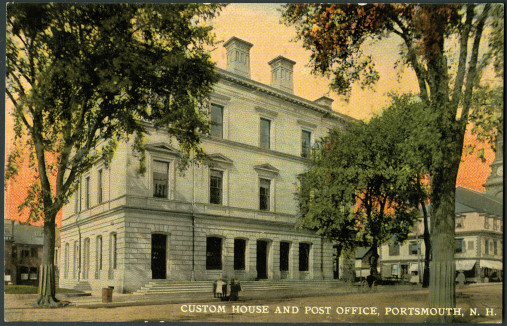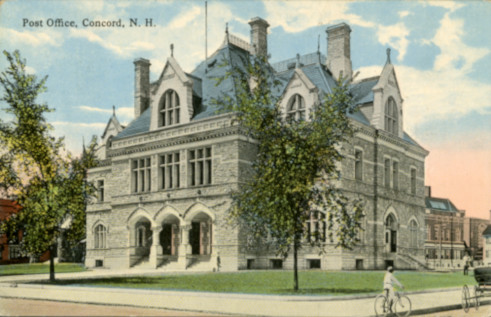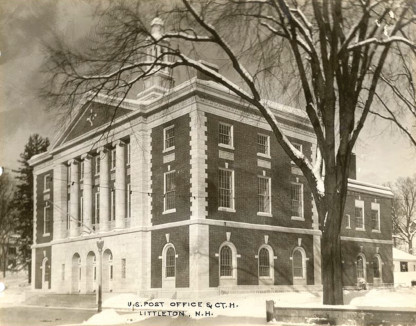26c. Places of Holding Court: Courthouses of the New Hampshire District
Located: 1st floor hallway at courthouse and federal building linkPrints in courthouse exhibit: Portsmouth State House; United States Custom House and Post Office in Portsmouth; Map showing location of Exeter Courthouse; Exeter Town Hall; postcards of the Merrimack County Courthouse, original Post Office and Courthouse in Concord, and Courthouse in Littleton
A history of the Courthouses of the New Hampshire Federal Judicial District.

Places of Holding Court: Courthouses of the New Hampshire District
Portsmouth: 1790-1926
On March 16, 1790, Judge John Sullivan welcomed twelve citizen jurors to the first session of the United States District Court held at New Hampshire’s State House in Portsmouth. Alternating with terms held in Exeter, the renowned State House would serve New Hampshire’s federal district and circuit courts for nearly five decades.
The two-story, wooden structure, built in 1758, stood conspicuously at the convergence of three busy streets in the center of town, now known as Market Square. A public market and meeting hall occupied the first floor, and New Hampshire’s Executive Council, Assembly, and courts of law met in three rooms on the second floor. By 1769, a cupola, roof-walk balustrade, and second-floor balcony were added, presenting a grand appearance for what was colonial New Hampshire’s official address.
The State House provided a dignified setting for Judge Sullivan, a Revolutionary patriot, lawmaker, and former President (Governor) of New Hampshire. (See: Spotlight on Judge John Sullivan, third floor.) Over the years, the State House had marked several momentous occasions in the young nation’s history, including public readings of both the Declaration of Independence in 1776 and the Peace Treaty after the American Revolutionary War in 1783. Nine lamps brightly illuminated each window to celebrate New Hampshire’s ratification of the United States Constitution as the critical ninth vote of the thirteen colonies, in 1788. President George Washington surveyed the town of Portsmouth from its balcony during his visit in the fall of 1789.
The “Old State House” eventually fell into disrepair, and was dismantled in 1836. Court sessions were then held in a smaller county court building several blocks away. In 1860, Portsmouth’s new United States Customs House and Post Office, constructed on Pleasant Street of Concord granite, included a third-floor courtroom. The circuit court met there until its abolishment in 1911, and the district court met there until 1926.
Exeter: 1789-1881
The Judiciary Act prescribed the first date and place of holding court for the District of New Hampshire: December 15, 1789, at Exeter, which had served as the state’s capital during the Revolution. After the United States Attorney took his oath of office and the commissions of other officers of the court were read into the record, court was adjourned. Accommodations for this brief session were probably less than regal. In 1731, the town’s small, original courthouse had been “built of the stuff of [the] old [meeting]house.”
By 1791, Exeter had a new courthouse, designated for use by both the local and federal judiciaries. Erected in the middle of the widened end of Court Street (today called Front Street), the wooden structure was literally encircled by town traffic, where the inescapable noise of center Exeter proved a serious distraction for the courts. After tolerating the commotion of busy, surrounding streets for over forty years, the town decided in 1834 to move the stately building. A crowd of onlookers gathered to witness the impressive spectacle: The courthouse was hoisted onto rollers and slowly tugged by two long lines of oxen to a quieter spot a few blocks west of its original location. Many years later, its vacated site would be more fittingly occupied by the town’s prized bandstand.
Just seven years after its relocation, the use of fire during an educational exhibit on “The Burning of Moscow” engulfed and destroyed the entire building. The court’s business soon resumed in a structure erected on the same site. By 1850, however, the town of Exeter undertook the construction of a grand town hall of brick and granite to be purposed for meetings, offices and the courts. Perhaps its most distinctive feature was a massive wooden statue of Lady Justice - 8 feet high and weighing 500 pounds – that was installed atop the town hall’s cupola. (An exact replica, carved in sturdy mahogany, replaced the weather-beaten original in 1992, and remains there today.) Both the United States district and circuit courts met there (alternating with Portsmouth) until 1881, when by congressional act, all terms held in Exeter were removed to Concord.
Concord: 1881- present day
New Hampshire’s population, business activity and political influence experienced a steady shift from the seacoast to its interior, such that by 1808, centrally located Concord became the permanent seat of state government. While the designation foreshadowed the eventual establishment of federal courts in Concord, it was a long time coming. The first convening of any true court of law in Concord occurred after the town was named the seat of Merrimack County in 1823, which prompted the enlargement of the “town house” to include a county courtroom. By mid-century, that building was already insufficient for the newly chartered city’s needs, and a City Hall and County Courthouse was erected. A full twenty-five years later (in 1881), the United States Congress designated Concord to host periodic terms of the federal judiciary, alternating with Porsmouth. When possible, the district and circuit court proceedings were held in a Merrimack County courtroom. Occasionally, less suitable rooms had to be used, due to scheduling conflicts in the busy facility.
With New Hampshire’s senior senator (Edward H. Rollins) seated as Chair of the Senate Committee of Public Buildings and Grounds, Congress appropriated the funding to build a United States Courthouse and Post Office in Concord. Construction on State Street began in 1884, providing a great deal of work for local stonecutters and masons. The building’s exterior walls of New Hampshire granite, backed by brick, measured three and a half feet thick. Gothic arches, dormers, and heavy decorative features were set against a steeply pitched slate roof and tall granite chimneys. Smooth-cut, polished stone artistically balanced the rough-hewn walls. Completed in 1889, the solid and ornate federal building gave credence to New Hampshire’s byname, “The Granite State”. The structure currently houses state governmental offices, and is known as the Legislative Office Building.
In 1965, the United States District Court moved to the new James C. Cleveland Federal Building at the corner of Pleasant and South Streets. These accommodations eventually proved inadequate for the ever-increasing business of New Hampshire’s busiest (and by 1979, its only) federal court. In 1997, an adjoining courthouse annex with the security, technology, and space requirements for the proper functioning of a modern federal court was constructed. The United States District Court, Bankruptcy Court, and Probation and Pretrial Services are now located in the Warren B. Rudman United States Courthouse.
Littleton: 1892-1979
Prior to serving as a district judge (1891-1921), prominent Littleton attorney Edgar Aldrich was a vocal proponent of establishing federal court sessions in the “North Country.” The area’s economy had surged in the late 1800s, as New Hampshire’s vast forests supplied the seemingly limitless demands of paper mills and other manufacturing concerns. New Hampshire’s connections by rail and waterways to mills throughout New England created plenty of business for lawyers practicing more than 100 miles north of the federal courts in Portsmouth and Concord.
In the spring of 1890, Attorney Aldrich traveled on behalf of Littleton’s Board of Trade to Washington, D.C. to seek congressional approval for holding annual terms of the federal court in Littleton. Within a year, Congress approved the change. Portsmouth, Concord and Littleton would share three annual circuit court sessions. Quarterly district court sessions would also be split between the three towns, with Concord hosting twice a year.
Littleton’s first circuit court session was held on July 19, 1892, in the Oak Hill House, a Victorian-style “grand hotel” that later burned to the ground. The district court leased space in downtown Littleton’s Opera Block from late 1892 until 1901, and then met in the National Bank building. Besides regular court sessions reportedly “crammed [with] prohibition violations and bankruptcies” in the early twentieth century, Littleton’s district court hosted busy naturalization ceremonies every two years. Congress discontinued court sessions in Portsmouth in 1926, after which Concord and Littleton served as the state’s two federal court venues.
In 1933, 42 years after the court’s congressional authorization, a large brick and marble United States Courthouse and Post Office was erected on Littleton’s Main Street. Elegant interior details were included at the insistence of District Judge George P. Morris, who had spent much of his career as a trial lawyer in neighboring Lancaster. It was later said that visiting judges often favored Littleton court assignments, but not because of the courthouse; rather, they enjoyed the area’s proximity to some of New Hampshire’s best ski trails.
District court sessions in Littleton ended in 1979, leaving Concord as the sole federal court location in the state. Many of the furnishings of the Warren B. Rudman Courthouse in Concord, including benches in the main hallways, originally adorned the Littleton courtroom.



Portsmouth State House c. 1758

United States Custom House and Post Office, Portsmouth c. 1860

Exeter Courthouse c. 1791 (Map by P. Merrill, 1802)

Exeter Town Hall c. 1855

Merrimack County Courthouse c. 1857

United States Post Office and Courthouse, Concord c. 1889

United States Post Office and Courthouse, Littleton c. 1933



